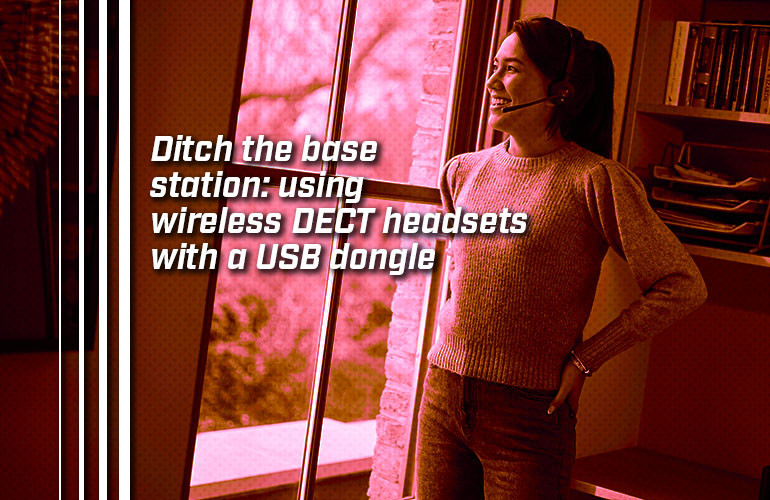There are two primary types of wireless headsets: Bluetooth Headsets and DECT Headsets. Bluetooth has the advantage of being the more familiar technology, available on every smartphone, computer and even, increasingly, on your VoIP phone.
DECT, however, has a few advantages over Bluetooth that makes it incredibly attractive for businesses. Here are three:
- Reduce spectrum density. As more and more wireless devices compete for the same sections of the wireless spectrum, problems can arise like loss of signal. Because most wireless devices use Wi-Fi or Bluetooth, those two sections see the most competition. DECT devices use a different section, which means they don’t compete with Wi-Fi or Bluetooth devices. In other words, by using a DECT headset, you get a stronger headset signal for yourself, while also improving the signal for other devices, too: win-win!
- Extended wireless range. DECT has a wireless range far beyond what the most powerful Bluetooth headset can offer. For example, the top-of-the-line Jabra Evolve2 65 Bluetooth Headset, an on-the-ear stereo headset with dual 40 mm speakers, has a roughly 100-foot range. Compare that with Jabra Engage 65 DECT Headset, which has an almost 500-foot range — 5x better than the Bluetooth headset!
- Security. Communications security is vitally important to business. Headset manufacturers have responded to the demands for increased security. Many of the newer DECT headsets feature improved security. For example, Jabra Engage 75 goes beyond DECT Security Level C with features like US military-grade FIPS 140-2 listed security algorithms and 256-bit encryption on the communication between the headset and its base.

So why doesn’t everyone use DECT?
One of the reasons is that, until recently, you needed a base station to use a DECT headset with your VoIP phone or computer. The headset communicates with its base. The base is connected via cable to the phone or computer. While this is certainly an excellent arrangement in the office, it doesn’t offer the mobility that Bluetooth affords. You can use a Bluetooth headset anywhere with any kind of device: that’s convenient.
But you’ll note we said “until recently” above. Headset manufacturers, seeing the many advantages of DECT, are trying to solve the problems associated with it.
One of the solutions is replacing the base station with a portable, plug-and-play USB dongle. Let’s take a look at the new Jabra Engage 55 DECT Headset to see it in action.

USB DECT dongles for headsets
Engage 55 is a new wireless headset designed with hybrid workers who primarily use softphones in mind.
The headset offers excellent audio quality, exceptional security and plug-and-play compatibility with basically every softphone on the market today using its included dongle. It’s certified for Microsoft Teams, Zoom and Google Meet. It also works with some VoIP phones that support USB headsets, for example, it has been tested and confirmed to work on Yealink T58V and AudioCodes 440HD.
The headset comes with the brand-new Jabra Link 400 DECT Adapter. We’re going to focus on this new USB dongle for DECT headsets.

Jabra Link 400 DECT Adapter
Link 400 is, well, a USB dongle. You use it like any other dongle: you plug it into a USB port. After that, you select the headset as your audio peripheral, just like using a Bluetooth headset dongle. There are four versions of it available:
- Jabra Link 400a UC DECT Adapter, USB-A (14205-13)
- Jabra Link 400c UC DECT Adapter, USB-C (14205-33)
- Jabra Link 400a MS DECT Adapter for Microsoft Teams, USB-A (14205-23)
- Jabra Link 400c MS DECT Adapter for Microsoft Teams, USB-C (14205-43)
Jabra designed Link 400 to be highly portable, perfect for hybrid workers who move between office and home. Essentially, it looks like a puck attached to a USB plug by a flexible silicon rubber connector. This connector is important. The bendable design improves durability and reduces the risk of damage, particularly if you move your laptop around with it still plugged in.
The puck features a single button for pairing with the headset. The button has a ring LED light around it, which lets you know status with different colors for active call, music playback, microphone muted and so on. The Microsoft Teams variant even lights up in Teams purple for notifications on that service.
The Link 400 adapter gives your wireless headset a range of nearly 500 feet. (Up to 490 feet in ideal conditions, to be precise.) That’s over a football field and a half!
And your communications are secure. It goes past DECT Security Level C, using US military-grade FIPS 256-bit encryption algorithms.

Can you use a Jabra Link 400 with an existing headset?
Yes. You can use the UC versions of the Link 400 adapter with Jabra Engage 65 and Engage 75 headsets. Note that you need to update the headset’s firmware before you can do so.
As of the publication of this blog, the Microsoft Teams versions of the Link 400 adapter are only usable with Jabra Engage 55. They will not work with Engage 65 or Engage 75.

